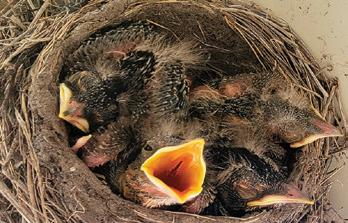
4 minute read
Treading wisely: Good-bye for now
Good-bye for now
ARTICLE AND PHOTOS BY ROSEMARY ROBERTSON
Advertisement
Every spring, we listen for the first sound of each bird species; loons, robins, red-winged blackbirds, and more. What a delight to hear the early morning songs of our returning feathered friends! There is great pleasure in observing their activities all summer. We notice their staggered departure in fall. However, their true value is unseen.
As major contributors to the health of the ecosystem, birds’ importance goes far beyond providing pleasure for us with their beauty and joyful songs. We need them. On the other hand, they face obstacles in life because of us. It doesn’t seem like a fair exchange. How can we help to right this wrong?
Perhaps the most significant function of birds is to disperse seeds. Who would have thought bird poop was such a generous offering? In essence, when birds go a ‘flying they take the seeds they have eaten with them. Through their droppings, the seeds are spread widely. The seeds create plants frequently in areas that were devoid of vegetation.

Moving a robin’s nest is never a good idea, even if it isn’t the best spot for us. A robin’s fidelity is not just the nest, but the whole nest setting. These hatchlings are comfortable right over our daughter’s front door.
We assume pollinators are bees or butterflies. We forget that those wonderful hummers we love to watch, are pollinators.
Did you know that birds pollinate five per cent of the plants we consume as food or medicine? If those birds were to disappear, the result could be drastic.
You may not have considered that birds eat and control pests to the tune of 400-500 million tons of insects per year. Evening grosbeaks, for example, may as well wear Superman capes during spruce budworm outbreaks. Who doesn’t love a good bug guzzler?
Talking about pest control, vultures are queens and kings. A group of turkey vultures circling about a dead carcass may seem creepy, but they are speedy and efficient. They dispose of remains quickly before other disease-carrying scavengers like rats or feral dogs arrive on the scene. Those scavengers are carrier/spreaders of rabies and tuberculosis, unlike the sky scroungers. Birds are environmental custodians.
A substantial boon to the world is that birds are the ‘bringers of news’ or messengers about the health of the planet. Let’s protect them and heed their warnings. Bird populations are widespread. They respond rapidly to environmental change, which becomes obvious to humans promptly as an early warning system of sorts.
The declines of bird populations are foreboding indicators of something extremely wrong happening in the natural world. Because we are part of that world, paying attention, finding the cause and eliminating it is advantageous to us. Birds inspire us to be citizen scientists. In the Early Spring 2022 issue of the Area News there will be information for interested birders about becoming involved in data collection for the 2022 breeding season. There is nothing like hands on experience to build understanding and knowledge about issues affecting birds. Because 12 per cent of all living birds are endangered, it behoves us to learn how we harm birds and how we can facilitate constructive change.
The major threats to bird populations are climate change, habitat loss, invasive species, collisions with structures and pesticides and toxins. The ways we can assist in safeguarding birds align with the threats. The pressing issue of climate change needs our help by supporting legislation that sets greenhouse gas reduction targets. Voting for legislators that honestly commit to fight climate change is crucial. Decreasing our own carbon footprint is requisite if we are serious about stemming this tide.
As we work away on our properties, leaving vegetation alone during nesting season will ensure successful mating and reproduction. This greatly aids the continuation of species.
It is essential that we find alternatives to pesticides and chemical fertilizers. Another problem for birds is the careless disposal of insect and rodent poison. This can kill birds but even if they don’t die, it might harm their reproductive systems irreparably.

All four eggs became healthy chicks. Their main predators are snakes, squirrels, cats, blue jays and crows.

The fledglings are ready to fly. To help them keep cats indoors, avoid insecticides, plant berry trees for food and shrubs for protection. Windows are their biggest threats.
Planting indigenous trees and flowers and building a pond or having a bird bath are also well-known suggestions. Covering your windows or putting predator silhouettes on windows help to keep birds from hitting them. It was my intention to make window decorations with our grandkids this summer before writing this article but somehow water fun won out. I found a great idea by Audubon to use on YouTube. It is a video called “Making Bird-Friendly Window Decorations”. I am going to keep it in my cache of activities for when the weather is cooler. Covering windows at night during migration periods is wise to avoid crashes as well.
Now that the birds have gone quiet in the mornings, and we are left with noisy but essential crows and ravens, I am filled with hope that this year’s juveniles have a safe trip south and that their return in spring 2022 will be as jubilant as ever.
So long, my fine feathered friends.










